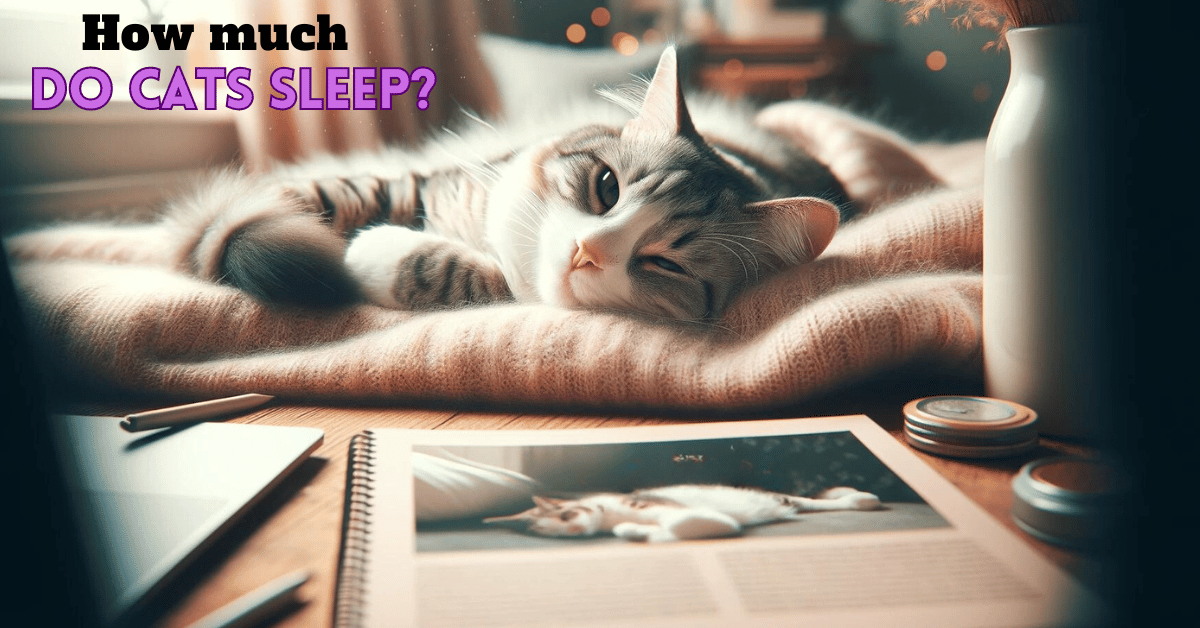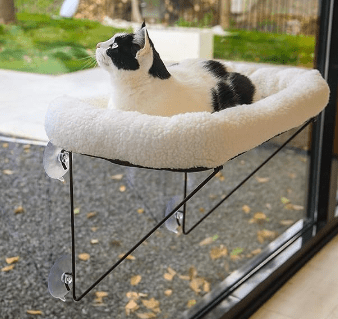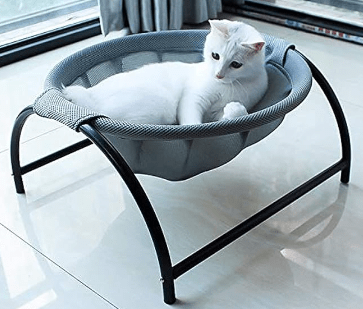This post contains affiliate links and I will be compensated if you make a purchase after clicking on my links.
Exploring Cat Sleep Patterns: How Much Do Cats Sleep (Really)?
How much do cats sleep? is a question many cat lovers ask as they observe their furry companions often lost in slumber, cozied up in their favorite spots. But there’s more to these frequent catnaps than meets the eye.
Understanding the intricacies of cat sleep isn’t just a curiosity – it’s key to ensuring their health and happiness, especially in our tech-driven world where we constantly seek ways to improve the lives of our pets through innovative solutions.
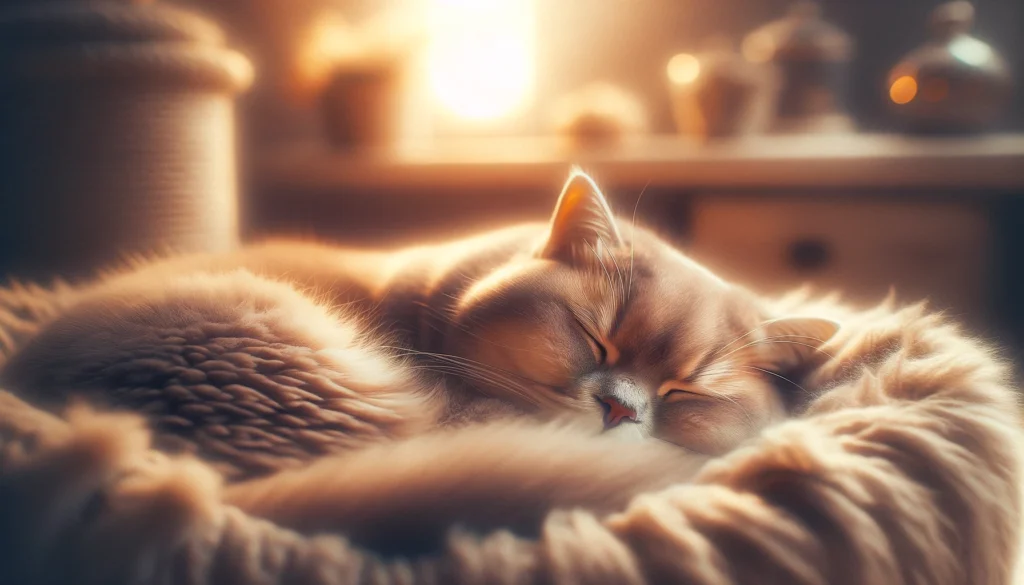
Understanding Cat Sleep Hours: From Kittens to Seniors
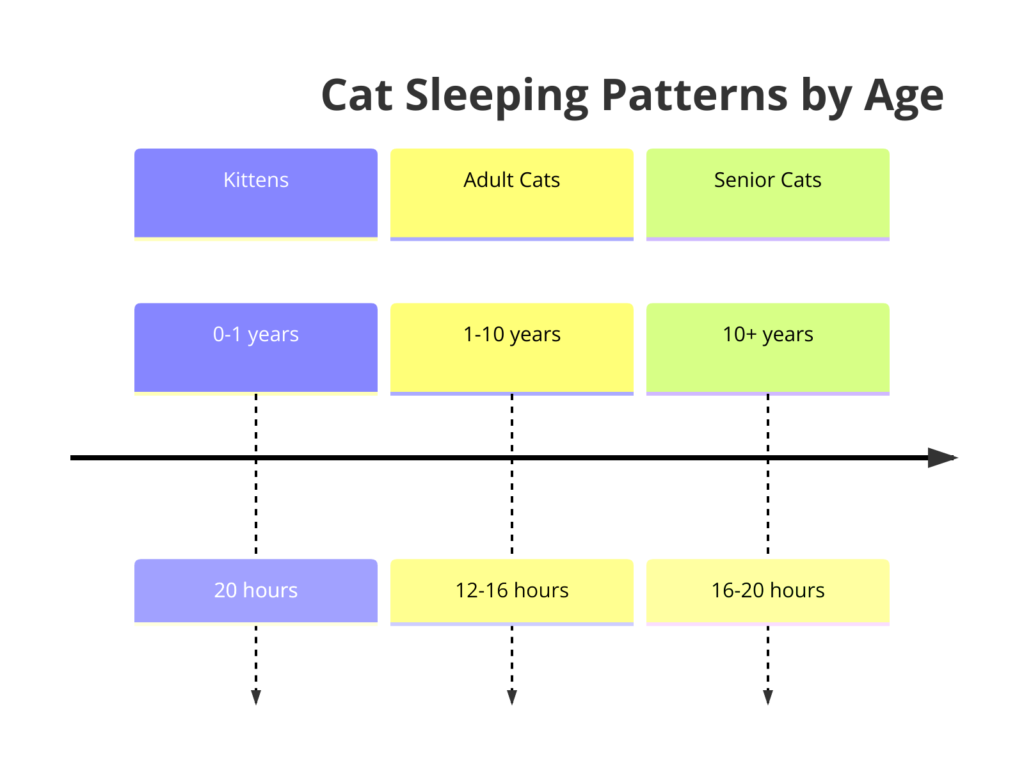
Cats are known for their love of sleep, but the amount they need can vary widely. On average, a typical house cat spends about 12 to 16 hours a day sleeping. However, this number can shoot up to 20 hours for kittens, who are growing rapidly and need extra rest.
Similarly, senior cats, often due to decreased activity levels and the natural aging process, tend to require more rest. It’s not uncommon for senior cats to sleep for about 16 to 20 hours a day, as their bodies demand more time for rest and recovery.
The sleep patterns of cats are fascinating and change throughout their lives. Kittens, bursting with energy, often have a sporadic sleep schedule, dozing off frequently after bursts of playful energy. As cats mature into adulthood, their sleep becomes more structured, but they still enjoy several catnaps throughout the day. This pattern shifts again as they enter their senior years, with longer and more frequent periods of rest.
Fun Fact: Did you know that at 10 years old, a cat is roughly equivalent to 56 years in human age? Curious about how other ages translate? Check out our Cat Age Calculator to discover your cat’s age in human years.
But why do cats sleep so much?
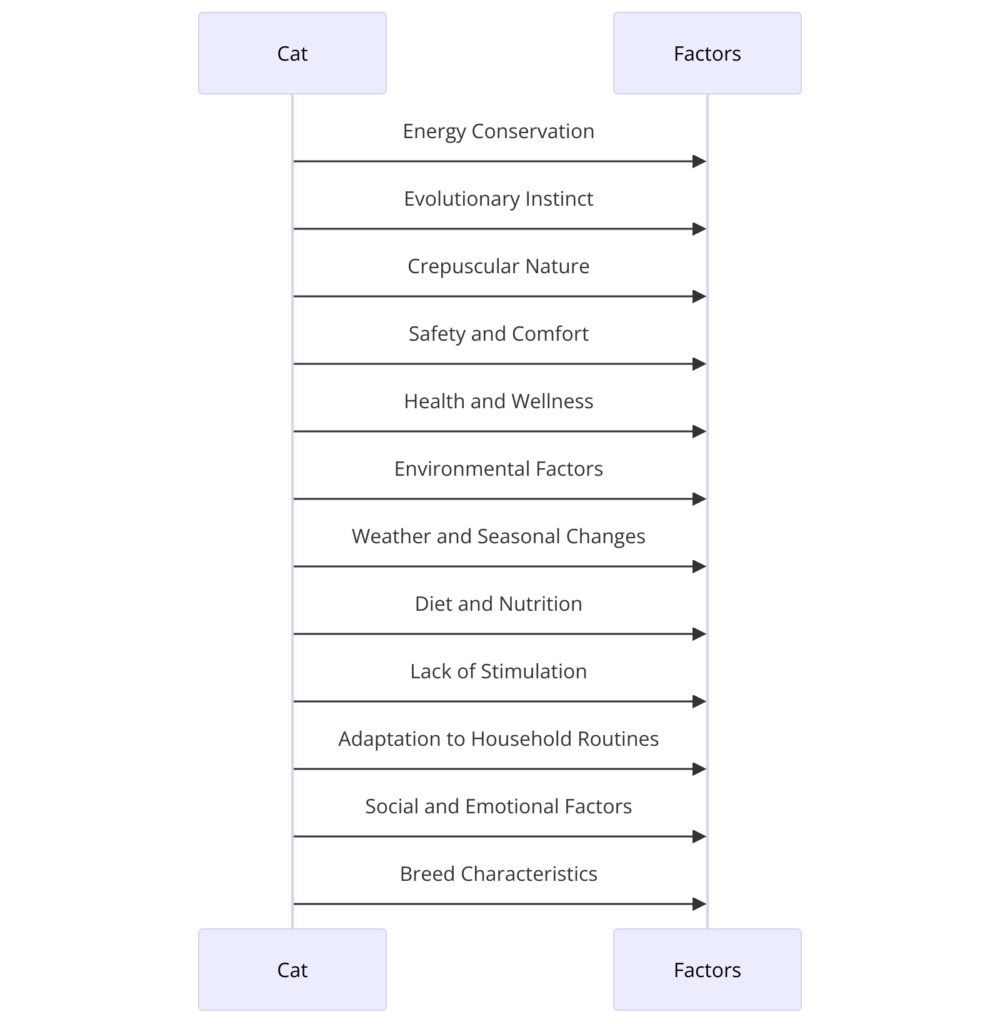
- Energy Conservation: Cats are natural predators, and in the wild, hunting requires short bursts of intense energy. Sleeping for long periods helps conserve energy for these high-activity moments.
- Evolutionary Instinct: This behavior is deeply ingrained in their biology from their ancestors. Even domestic cats, who don’t need to hunt for survival, retain this instinctual pattern.
- Crepuscular Nature: Cats are naturally more active during dawn and dusk. This means they are inclined to rest during the day and at night, aligning their sleep patterns with their natural hunting times.
- Safety and Comfort: In a state of rest, cats can quickly react to potential threats or opportunities. This sense of security and comfort in their environment can also influence their sleep duration.
- Health and Wellness: Sometimes, an increase in sleep can indicate health issues like hyperthyroidism, diabetes, or arthritis. Similarly, stress or boredom can also lead to increased sleep in cats.
- Environmental Factors: Domestic cats’ sleep patterns can be influenced by their living environment, including the presence of humans, other pets, and the overall home setting.
- Weather and Seasonal Changes: Cats may sleep more during certain weather conditions or seasons. For example, cold or rainy weather can make cats more inclined to find a cozy spot and sleep.
- Diet and Nutrition: The quality and quantity of a cat’s diet can influence their sleep patterns. A diet that is either lacking in nutrients or overly rich can lead to increased sleepiness.time.
- Social and Emotional Factors: Cats’ emotional well-being can impact their sleep. Cats that are lonely or depressed might sleep more, while those in a stimulating, loving environment may have more active periods.
- Breed Characteristics: Some cat breeds (Persian cats) are naturally more predisposed to longer periods of sleep than others. This can be due to genetic traits that influence their activity levels and sleep needs.
Cat Sleep Stages Explained: REM and Non-REM in Felines
When cats hit the hay, their sleep cycles are quite similar to ours, comprising Rapid Eye Movement (REM) and non-REM stages. The REM stage, often associated with dreaming, is where you might see your cat’s whiskers twitch or paws flutter as if chasing imaginary mice in their dreams. The non-REM stage is more about deep, restful sleep. These cycles are crucial for their cognitive functions and overall well-being.
Tech-savvy cat owners can now delve deeper into their cat’s sleep mysteries with the help of modern gadgets. Sleep trackers and monitors have become increasingly popular, providing insights into how long and how well our feline companions sleep. These devices can track sleep patterns, detect any disturbances, and even offer suggestions to improve sleep quality.
And let’s not forget the amusing aspect of watching cats sleep in various, sometimes gravity-defying positions. Each pose, from the classic curled-up ‘cat loaf’ to the more vulnerable ‘belly-up’, tells a story about your cat’s mood and comfort levels.
Fun Fact: Did you know that cats can dream? Scientists believe that cats experience REM (Rapid Eye Movement) sleep, just like humans. So, when you see your cat twitching in their sleep, they might be chasing dream mice!
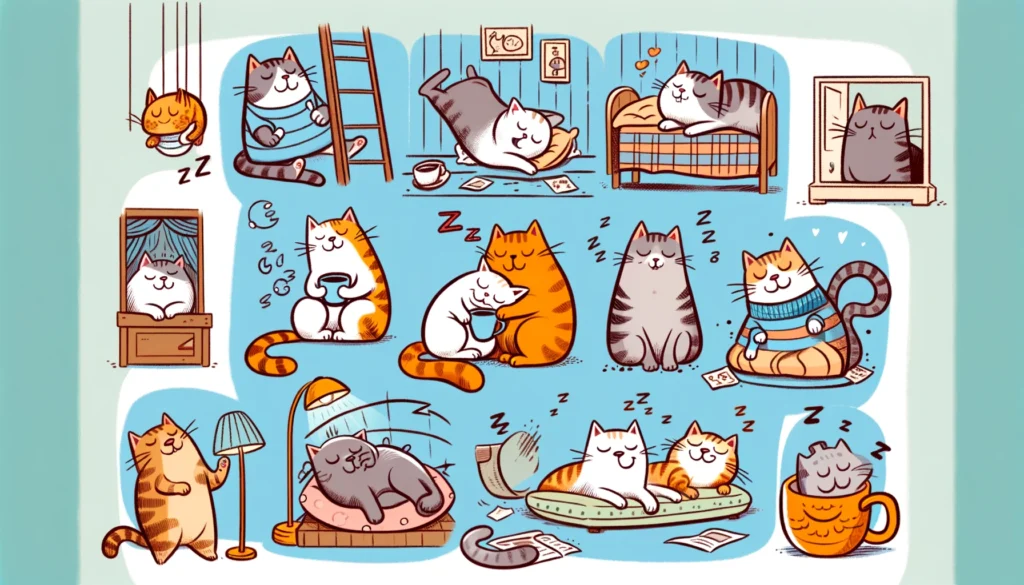
Common Cat Sleep Disorders: Signs and Solution
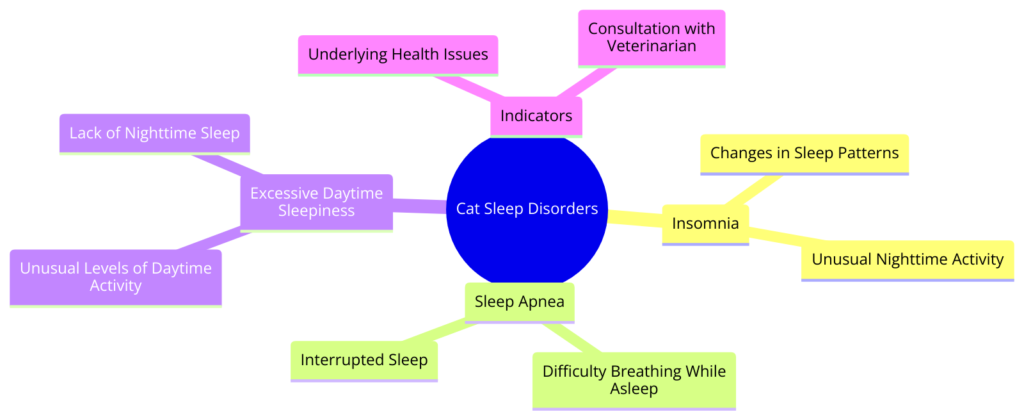
Despite their proficiency in sleeping, cats can suffer from sleep disorders too. Disorders like insomnia, sleep apnea, or excessive daytime sleepiness can affect cats, often indicating underlying health issues. Be on the lookout for signs like changes in sleep patterns, difficulty breathing while asleep, or unusual levels of activity during normal sleeping hours.
In such cases, consulting a veterinarian is crucial. They can provide professional advice, diagnose any underlying issues, and suggest treatments or behavioral strategies to improve sleep quality.
Creating the Ideal Sleep Environment: Tips for Your Cat’s Rest
Creating the purr-fect sleep environment for your cat can be both a fun DIY project and a great opportunity to indulge in some cool cat-tech. Here’s how you can approach this:
- DIY Cozy Cat Beds: Roll up your sleeves and get creative! Use upcycled materials like old sweaters or soft blankets to craft a simple yet comfy cat bed. You don’t need to be a DIY guru – just a little creativity and love for your feline friend. This approach not only gives a personal touch but is also kind on the wallet.
- Ready-Made Cat Bed Options: For those who are more ‘click and buy’ than ‘cut and sew’, the market is teeming with cat bed options that won’t break the bank. From plush donuts to elevated perches, there’s something for every cat’s preference and every owner’s budget. It’s all about convenience and comfort.
Improving Cat Sleep: Practical Tips for Cat Owners
Enhancing your cat’s sleep quality goes beyond just a comfy bed.
It’s also crucial to consider potential factors of boredom or stress. Engaging in playtime with cat-centric gadgets, like cat wheels, and providing amenities such as climbing trees and puzzle feeders for mental stimulation, can significantly enhance their quality of life.
Additionally, the companionship of other pets or humans is beneficial. When it comes to health-related increases in sleep, appropriate medical care, dietary adjustments, and supplements can have a considerable impact
If you want a budget friendly cat wheel the Home Groove wheel is a great option.
Monitoring Your Cat’s Sleep: Health and Behavior Insights
Keeping a close eye on your cat’s sleeping habits offers crucial insights into their health and emotional state. Subtle changes in their sleep patterns can be early indicators of health or stress-related issues. Ensure regular veterinary check-ups to maintain optimal health. Additionally, providing a variety of activities and safe, quiet spaces can foster a healthy environment, crucial for their overall well-being
Wrapping Up: Understanding How Much Do Cats Sleep
The world of cat sleep is deep and intriguing. Understanding how much cats sleep is a crucial part of being a responsible cat owner. This knowledge offers us a window into their well-being and health. As we ponder the dreams that might dance in their minds, we realize the importance of ensuring a healthy sleep pattern for our cats. It’s an essential aspect of their care and happiness.
We’d love to hear your thoughts and experiences. Do you have any interesting stories about your cat’s sleeping habits? Or perhaps you’ve created a unique sleep space for your furry friend?
Meet Sean, a fintech whiz with a penchant for pet purrs and blockchain buzz. After a decade of fintech feats, Sean's tech talents leaped from ledger lines to litter lines, driven by a passion for pets and a vision for a more connected pet care community. With three critter companions as co-pilots, Sean launched this blog to share a treasury of pet-friendly tech tips and tales.

